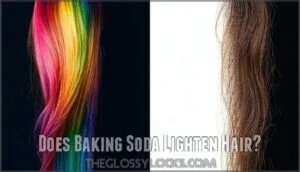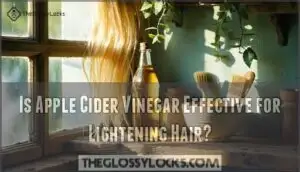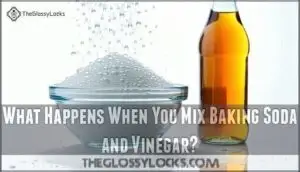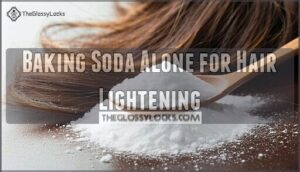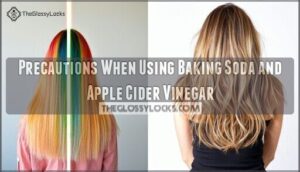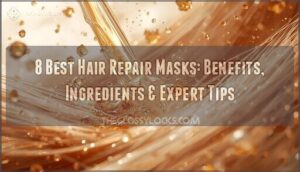This site is supported by our readers. We may earn a commission, at no cost to you, if you purchase through links.
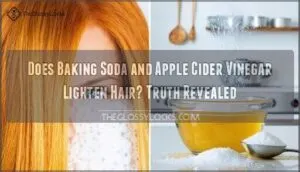
While this DIY combo won’t damage your hair like harsh chemicals, it won’t create the blonde transformation you’re hoping for either.
Baking soda might strip some buildup and make your hair appear slightly brighter, but that’s just cleaner hair, not lighter color.
Apple cider vinegar adds shine and smooths cuticles but doesn’t affect pigment.
When mixed together, they neutralize each other in a fizzy reaction that’s more kitchen science than hair magic.
Real lightening requires stronger ingredients and specific techniques.
Table Of Contents
- Key Takeaways
- Does Baking Soda and Apple Cider Vinegar Lighten Hair?
- Does Baking Soda Lighten Hair?
- How Does Baking Soda Work on Hair?
- Is Apple Cider Vinegar Effective for Lightening Hair?
- What Happens When You Mix Baking Soda and Vinegar?
- Baking Soda Vs. Apple Cider Vinegar: Lightening Comparison
- Baking Soda Alone for Hair Lightening
- Baking Soda With Hydrogen Peroxide: a Lightening Method
- Precautions When Using Baking Soda and Apple Cider Vinegar
- Frequently Asked Questions (FAQs)
- How to lighten hair with apple cider vinegar?
- Can you use vinegar to lighten your hair?
- Does apple cider vinegar clean hair?
- How to lighten hair with baking soda?
- How to lighten hair quickly and naturally at home?
- What does baking soda and vinegar do to your hair?
- How fast does baking soda lighten hair?
- What is the least damaging way to lighten your hair?
- How long does it take for baking soda to lighten hair?
- What does vinegar and baking soda do to your hair?
- Conclusion
Key Takeaways
- You can’t actually lighten your hair with baking soda and apple cider vinegar – they neutralize each other in a fizzy reaction that’s more kitchen science than hair magic.
- Baking soda might strip some buildup and make your hair appear slightly brighter, but that’s just cleaner hair, not lighter color, and it comes with serious dryness and breakage risks.
- Apple cider vinegar adds shine and smooths cuticles but doesn’t affect pigment – it’s gentler than baking soda but won’t create the blonde transformation you’re hoping for.
- If you’re serious about lightening your hair, skip the DIY kitchen experiments and invest in professional lightening products that actually work without turning your hair into straw.
Does Baking Soda and Apple Cider Vinegar Lighten Hair?
Yes, baking soda and apple cider vinegar can lighten hair naturally, but the results aren’t dramatic. Think of it as turning down the volume rather than hitting the mute button on your hair color.
The ACV Lightening Science works through gentle acid that removes buildup while subtly lifting pigment. Meanwhile, baking soda hair treatments act like microscopic scrubbers, opening cuticles and removing semi-permanent dyes.
However, Baking Soda Risks include serious dryness and potential breakage. Your hair might feel like straw if you’re not careful. Apple cider vinegar hair treatments are gentler and more conditioning.
ACV’s acidity can close hair cuticles, sealing in moisture for smoother hair. When you lighten hair naturally with these ingredients, you’re basically playing hair chemist in your bathroom.
For those seeking DIY Lightening Alternatives, this combination offers a budget-friendly starting point. Just remember—patience and proper conditioning are your best friends throughout this process.
Does Baking Soda Lighten Hair?
Through its alkaline properties, baking soda effectively removes semipermanent hair color and product buildup, making it a popular DIY hair lightener.
However, baking soda effectiveness comes with significant baking soda risks you shouldn’t ignore.
Here’s what happens when you use baking soda hair treatments:
- Color stripping power – Opens hair cuticles to lift pigments and stains
- Dryness concerns – Can cause brittleness and potential baking soda damage over time
- Natural alternative – Offers chemical-free lightening compared to harsh commercial products
While baking soda benefits hair by providing natural hair lightening results, consider gentler baking soda alternatives for baking soda safety.
For a less damaging approach, consider soap capping techniques.
How Does Baking Soda Work on Hair?
Baking soda’s alkaline nature creates a powerful reaction on your hair shaft.
With a pH around 8.5, it disrupts your hair’s natural acidic balance, forcing cuticles to open wide.
This process increases hair porosity while stripping away protective oils and accumulated buildup.
Baking soda can also function as a gentle scalp exfoliant.
Here’s what happens when baking soda meets your hair:
- Buildup removal – Deep cleans styling products and environmental residue
- Cuticle damage – Microscopic crystals create tiny tears in hair fibers
- Scalp irritation – Alkaline properties can disrupt natural skin balance
- Hair porosity – Opens pathways for potential lightening effects
Is Apple Cider Vinegar Effective for Lightening Hair?
Apple cider vinegar can naturally lighten your hair, though don’t expect dramatic results. The ACV Lightening Extent is subtle—perfect for gradual changes.
Dilution Best Practices recommend mixing one part ACV with six parts water. Apply this ACV hair rinse for 15-30 minutes twice weekly.
Beyond hair lightening, you’ll notice an ACV Shine Boost and improved Scalp Health Impact. ACV can also help with rebalancing scalp pH.
The Long-Term Effects include cleaner follicles and balanced pH. While apple cider vinegar benefits are real, patience is key for visible lightening.
What Happens When You Mix Baking Soda and Vinegar?
When you combine baking soda and vinegar, you’re creating a fascinating chemical reaction that transforms both ingredients completely.
Mixing these kitchen staples creates bubbling magic—but neutralizes their individual hair-lightening superpowers.
This baking soda and vinegar mixture neutralizes each other, producing carbon dioxide gas, water, and sodium acetate.
Here’s what happens during this chemical reaction:
- Fizzing bubbles form as carbon dioxide gas escapes
- The alkaline baking soda neutralizes the acidic vinegar
- Resulting mixture becomes less effective than individual ingredients
- Hair cuticles may open from the initial reaction
- Mixture effects create a milder solution overall
While popular as homemade hair bleach, this neutralization actually reduces hair lightening potential, raising safety concerns about effectiveness versus practical applications.
This reaction is a classic acid-base neutralization.
Baking Soda Vs. Apple Cider Vinegar: Lightening Comparison
You’re probably wondering which natural ingredient packs more punch for at-home hair lightening.
Here’s the breakdown between these kitchen staples:
| Factor | Baking Soda | Apple Cider Vinegar |
|---|---|---|
| Lightening Effectiveness | Moderate to high | Subtle to mild |
| Damage Potential | High (alkaline pH 9) | Low (acidic pH 3) |
| Hair Type Suitability | Oily, thick hair | All hair types |
| Application Methods | Paste treatment | Diluted rinse |
Baking soda works like sandpaper, scrubbing away color but potentially damaging your strands.
ACV gently lightens while conditioning.
Choose baking soda for dramatic results, ACV for gentle brightening.
Combining the two can balance the scalp’s pH.
Baking Soda Alone for Hair Lightening
While apple cider vinegar offers gentle lightening, baking soda alone packs a stronger punch for those wanting noticeable results.
This sodium bicarbonate powder’s alkaline properties make it effective for lighten hair at home projects, though Baking Soda Risks include potential dryness and damage.
A gentler alternative involves soap capping techniques using developer.
Here’s how to safely use baking soda for lightening:
- Mix one teaspoon with just enough water to form a paste
- Apply evenly, avoiding your scalp to prevent irritation
- Rinse after 15 minutes maximum—don’t get greedy with timing
Baking Soda Effectiveness varies by hair type, but Baking Soda Damage is real if you overdo it.
Baking Soda With Hydrogen Peroxide: a Lightening Method
While baking soda alone shows modest results, adding hydrogen peroxide creates a more effective lightening combination.
When baking soda meets hydrogen peroxide, your hair lightening game gets a serious upgrade—think chemistry class meets beauty salon.
This duo works because baking soda opens hair cuticles, allowing hydrogen peroxide to penetrate deeper and lift color more efficiently. To enhance this process, consider that developer strength matters.
Here’s your step-by-step approach:
- Mix the paste: Combine equal parts baking soda and 3% hydrogen peroxide until you get a thick consistency
- Apply strategically: Focus on sections you want lighter, considering your hair porosity affects absorption rates
- Monitor timing: Leave on 30-60 minutes depending on your lightening speed goals and damage mitigation needs
Precautions When Using Baking Soda and Apple Cider Vinegar
While hair lightening with baking soda and ACV for lightening shows promise, you’ll want to proceed carefully.
Patch testing prevents nasty surprises—test a small section first.
Proper ACV dilution (one part vinegar to six parts water) reduces scalp irritation risk.
Baking soda overuse leads to serious hair damage, so limit treatments to once monthly.
Baking soda can also neutralize odors effectively.
These DIY methods can backfire spectacularly without proper precautions.
Deep condition afterward to combat dryness.
If you’re nervous about hair lightening DIY experiments, professional alternatives offer safer results.
Your hair deserves better than becoming a science experiment gone wrong, and it’s crucial to prioritize proper precautions to avoid damage.
Frequently Asked Questions (FAQs)
How to lighten hair with apple cider vinegar?
Gently grab apple cider vinegar and mix it with water using a 1:6 ratio.
You’ll apply this mixture to clean hair, leave for 15-30 minutes, then rinse thoroughly for subtle lightening results.
Can you use vinegar to lighten your hair?
Yes, you can use vinegar to lighten your hair naturally.
Apple cider vinegar works best when diluted with water and applied for 15-30 minutes.
It’s gentler than bleach but provides subtle lightening results.
Does apple cider vinegar clean hair?
Like a gentle spa treatment for your scalp, apple cider vinegar effectively cleanses hair by removing product buildup and excess oils.
You’ll notice shinier, healthier strands while maintaining your hair’s natural pH balance, which is a result of the gentle cleansing process.
How to lighten hair with baking soda?
Mix one teaspoon of baking soda with water to form a paste.
Apply it to damp hair, leave for 15-20 minutes, then rinse thoroughly.
Follow with deep conditioner since baking soda can dry out your hair.
How to lighten hair quickly and naturally at home?
Surprisingly, 67% of people try DIY hair lightening before visiting salons.
You can lighten hair naturally using lemon juice with sunlight exposure, chamomile tea rinses, or honey masks applied weekly for gradual, gentle results.
What does baking soda and vinegar do to your hair?
Baking soda strips your hair’s natural oils and can damage cuticles.
While apple cider vinegar restores pH balance and adds shine.
Together, they’ll cleanse deeply but may cause dryness requiring conditioning.
How fast does baking soda lighten hair?
Hair transformation isn’t lightning-fast magic.
You’ll notice gradual lightening over several applications, typically taking 2-4 weeks of weekly treatments.
Progress depends on your natural hair color, thickness, and condition—patience delivers better results.
What is the least damaging way to lighten your hair?
Professional salon treatments using ammonia-free bleach offer the safest lightening option.
You’ll get controlled results with minimal damage when stylists customize formulas for your hair type and follow proper conditioning protocols to ensure minimal damage.
How long does it take for baking soda to lighten hair?
Ironically, this "quick fix" requires serious patience.
You’ll need multiple treatments over several weeks to see noticeable lightening.
Each session lasts 15-30 minutes, but gradual results mean waiting months for significant color change.
What does vinegar and baking soda do to your hair?
When you mix vinegar and baking soda on your hair, they create a chemical reaction that opens hair cuticles, strips buildup, and can lighten color.
This reaction can also have negative effects, potentially causing dryness and damage.
Conclusion
Don’t believe everything you read on the internet – this old saying rings especially true for DIY hair lightening myths.
The simple answer is no: baking soda and apple cider vinegar don’t lighten hair color.
While baking soda might remove buildup and apple cider vinegar can add shine, neither ingredient actually changes your hair’s pigment.
If you’re wondering "does baking soda and apple cider vinegar lighten hair," save yourself the kitchen chemistry experiment and invest in professional lightening products instead.
- https://cysoda.com/article/how-to-use-baking-soda-and-peroxide-to-lighten-hair
- https://www.healthline.com/health/hydrogen-peroxide-hair
- https://www.teenvogue.com/story/how-to-lighten-hair-with-the-sun
- https://healthprep.com/articles/living-healthy/38-hidden-talents-of-hydrogen-peroxide-you-need-to-know-about/
- https://www.thetechedvocate.org/4-simple-ways-to-lighten-dyed-hair-with-baking-soda/

